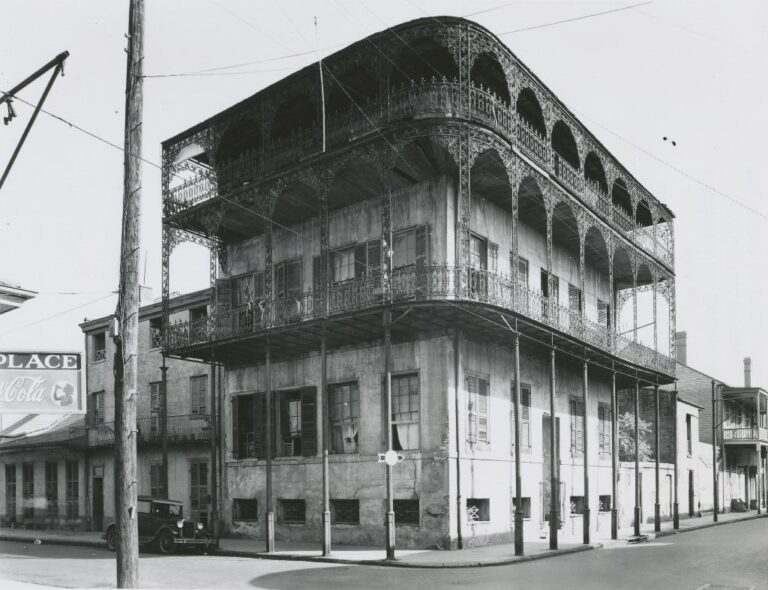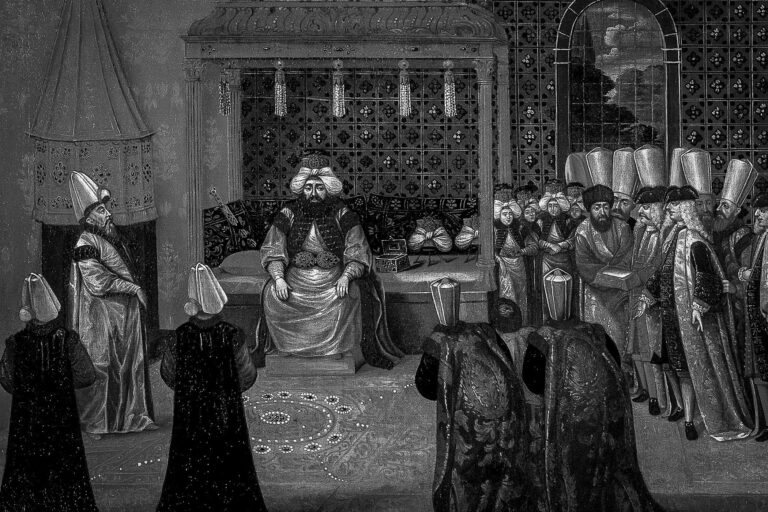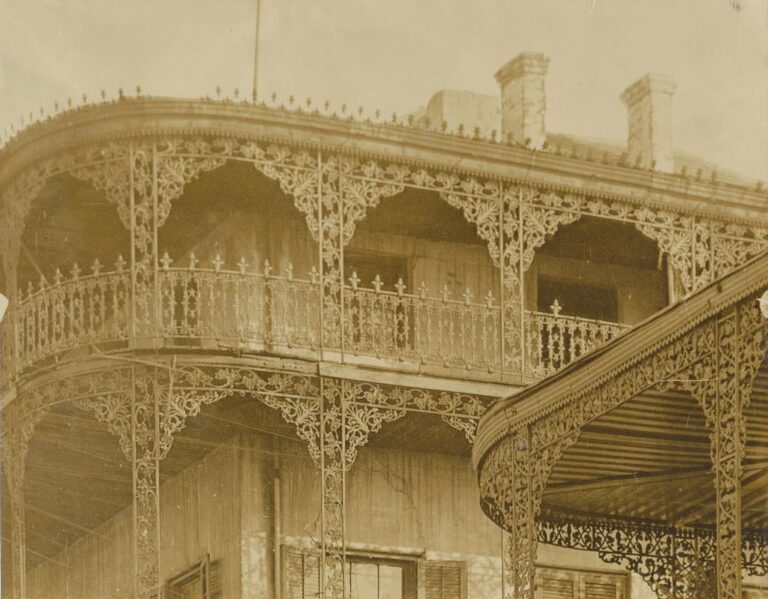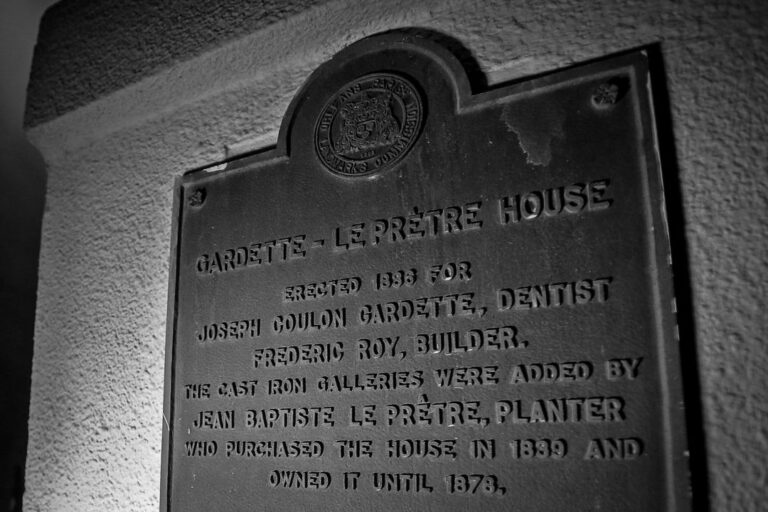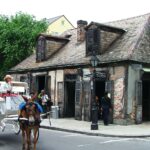At 188 years old, the Gardette-LePretre mansion is renowned as one of the most photographed in New Orleans. This could be because of the unique cast-iron filigree balconies it boasts on its upper levels or because of its horror-movie style story. Let’s explore the history of this historic mansion located in the French Quarter of New Orleans.
The Sultan’s House
The Gardette-LePretre Mansion, also known as the Sultan’s House, sits in the French Quarter of New Orleans. Legend has it that, at some point during the mid-1800s, Jean Baptiste LePretre, owner of the mansion, rented his house to the brother of a Sultan without knowing that the man was actually a fugitive and had stolen the riches of the sultan himself. The story ends in tragedy, with the vicious murder of the sultan’s brother and all of his entourage right inside the mansion.
The house, built by dentist Joseph Coulon Gardette in the 1830s, passed into the hands of Jean Baptiste LePretre, a wealthy plantation owner, in 1839. Legend has it that for a period LePretre leased it to a wealthy Turkish man, although historical records about this period are somewhat murky. As we anticipated, the most famous event associated with the mansion was the murder of its occupants, which occurred just a few years after the house was built. According to the legend, the man who pretended to be the brother of the sultan lived there lavishly with his harem. One night, a massacre took place, resulting in the deaths of all occupants except for one woman who survived by hiding. The gruesome nature of the crime, coupled with the mysterious background of the Gardette-LePretre Mansion’s occupants, fueled legends and ghost stories about the place.
Of course, it’s a legend, and there isn’t much evidence to back it up. But, for those who are fascinated by these stories, the Sultan’s House represents a special place, without a shadow of a doubt.
The French Quarter
Today, the French Quarter of New Orleans holds a place of fame and fascination, drawing people from around the world with its rich history and culture. Established in the 18th century, its heritage is easily admired thanks to the beautifully preserved architecture, storied streets, and historic houses. The Quarter’s iconic Creole townhouses, adorned with intricate balconies and colorful shutters, offer a glimpse into a long-gone era, evoking a unique sense of nostalgia and charming visitors and inhabitants alike.
What truly sets the French Quarter apart is its diverse cultural influences stemming from centuries of colonization and immigration. The area’s French and Spanish origins are evident in its street names, such as Chartres and Toulouse, while African and Caribbean flavors add a special touch to its music, art, and cuisine. This blending of traditions has created a dynamic atmosphere that is unique in the U.S. and which deserves all the attention it gets.
Walking through the Quarter’s labyrinthine streets, you will find countless landmarks and hidden gems. From the historic Jackson Square, flanked by the iconic St. Louis Cathedral and surrounded by street performers and local artists, to the jazz beats that pour out from cozy clubs along Bourbon Street, every corner of the French Quarter is special in its own way.
The French Quarter’s history is intertwined with tales of resilience and revival. Despite facing challenges such as fires, epidemics, and hurricanes, the community has always bounced back, showcasing a spirit of resilience and creativity. Preservation efforts led to the establishment of the Vieux Carré Commission in the 1930s, ensuring that the Quarter’s architectural treasures remain intact for future generations.
Today, the Quarter continues to captivate visitors with its original mix of history, art, and hospitality. It serves as a cultural hub, hosting festivals like Mardi Gras and the French Quarter Festival, where music, food, and revelry are at the center.
The First Owners of the Gardette-LePretre Mansion
There isn’t much information about the man who had the house built, a dentist from Philadelphia named Joseph Coulon Gardette, but we do know a little bit more about his successor.
Jean Baptiste LePretre was a wealthy man; his fortune came from owning a plantation on the Mississippi River and being a merchant. At the time, planters usually lived on their plantations during the warmest months of the year and moved to their city homes once the harvest season was over, right in time to take part in the social events of the city. The family of Jean Baptiste LePretre lived in the mansion until 1878 when the house went into the hands of a bank following a lawsuit against Jean Baptiste LePretre himself.
The Many Lives of the Gardette-LePretre Mansion
The house, with its rather long existence, has served many purposes and different owners throughout the decades. Jean Baptiste LePretre owned it until 1878; in the 1930s, it was subdivided into the so-called Saba Apartments, and it even hosted the New Orleans Academy of Art in the 1940s. For the following two decades, the Gardette-LePretre Mansion sat abandoned until the end of the 1960s, when it was built and renovated to the look that it still has today.
The Gardette-LePretre Mansion is occasionally open for tours, drawing visitors intrigued by its dark past and architectural beauty.

